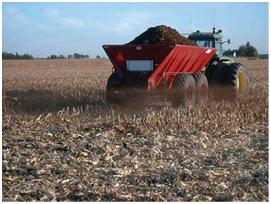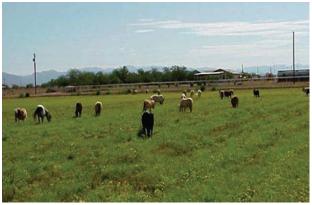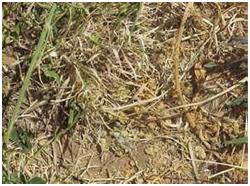Good Management Practices for use on cropland
- Artificial Wind Barrier
- Cover Crop
- Cross-Wind Ridges
- Cross-Wind Strip-Cropping
- Cross-Wind Vegetative Strips
- Manure Application
- Mulching
- Permanent Cover
- Residue Management
- Sequential Cropping
- Surface Roughening
- Transgenic Crops
- Tree, Shrub, or Windbreak planting
1. Artificial Wind Barrier
Artificial Wind Barrier means a physical barrier to the wind. Artificial wind barriers disrupt the erosive flow of wind over unprotected areas thus helping to reduce crop damage.
Suggestions for Implementation
- Continuous board fences, burlap fences, crate walls, bales of hay and similar material can be used to control air currents and blowing soil.
- Barriers should be aligned across the prevailing wind direction. While 90 degrees or perpendicular is preferred, benefits can still be realized when barriers are aligned as close to perpendicular as possible.
- The distance of 10 times the barrier height is considered the protected area downwind of the barrier.
2. Cover Crop
Cover Crop means plants or a green manure crop grown for seasonal soil protection or soil improvement. Cover crops help control soil movement and protect the soil surface between crops. Cover crop reduces wind erosion by shielding the soil with vegetation and anchoring the soil with roots.
Suggestions for Implementation
Cover crops consist of any vegetative cover that maintains more than 60 percent ground cover.
Short-term cover is grown between major crops. Plants are then tilled into the soil prior to or during major crop planting. Longer-term cover may be maintained by periodic mowing to maintain at least 60 percent cover.
3. Cross-Wind Ridges
Cross-Wind Ridges means soil ridges formed by a tillage operation. Ridges formed by tillage operations create protective windbreaks that disrupt the erosive forces of high winds.
Suggestions for Implementation
Ridges formed by tillage or planting should be aligned across the prevailing wind direction.
While 90 degrees or perpendicular is preferred, benefits can still be realized with ridges as close to perpendicular as possible. If ridges deteriorate and become ineffective due to weathering or erosion, they should be reestablished, unless doing so would damage a growing crop. This practice is Good adapted on soils, which are stable enough to sustain effective ridges, such as clayey, silty and sandy loam soils. It is not well adapted on unstable soils, such as sands, loamy sands and certain organic soils.
4. Cross-Wind Strip-Cropping
Cross-Wind Strip-Cropping means planting strips of alternating crops within the same field.
Growing crops or managing residue as a protective cover in strips across the prevailing wind direction can break the effects of high wind events.
Suggestions for Implementation
Cross-wind strip-cropping system consists of at least two crop or residue cover alternating strips.
Strip widths should be at least 25 feet but no more than 330 feet. Strips should be aligned across the prevailing wind direction. While 90 degrees or perpendicular is preferred, benefits can still be realized when the strips are oriented as close to perpendicular as possible. Protective cover includes, but is not limited to a growing crop, grasses, legumes, grass-legume mixtures, standing stubble or tilled residue with enough surface cover to provide protection.
5. Cross -Wind Vegetative Strips
Cross-Wind Vegetative Strips means herbaceous cover established in 1 or more strips within the same field. Herbaceous cover creates a protective windbreak that disrupts the erosive forces of high winds, especially during critical wind erosion periods.
Suggestions for Implementation
Herbaceous cover should be composed of perennial or annual vegetation, growing or dead.
Strips consist of at least one row of plants, providing the porosity can be achieved with a single row that contains no gaps. When two or more rows are required to achieve the required porosity and to avoid gaps, the rows should be spaced no more than 36 inches apart. Annual vegetation strips be composed of more than one row. Strips designed for this purpose have a minimum expected height of two feet. Strips designed for this purpose achieve a minimum porosity of 40 to 50 percent. Spacing between strips (not within row) not exceeds 12 times the expected height of the herbaceous cover. Spacing between strips is adjusted to accommodate widths of farm equipment to minimize partial or incomplete passes.
6.Manure Application

Manure Application means applying animal waste or bio-solids to a soil surface. Applying manure to maintain or improve chemical and biological condition of the soil can help reduce wind erosion.
Suggestions for Implementation
• If the application or storage of manure is near a water source, precautions should be taken to prevent accidental leakage, spillage or runoff that will result in undesirable effects on soil, water and plants.
• Caution should be used when applying manure to ensure that state and local regulations are not violated.
• Caution should be used when certain manures are applied as they can volatilize and contribute to odor and ammonia emissions.
• Manures should be incorporated as quickly as possible to reduce odor and ammonia emissions, and to preserve nutrient value if the area is to be cropped in the future.
7. Mulching

Mulching means applying plant residue or other material that is not produced on site to a soil surface.
Adding a protective layer to the soil surface reduces soil movement in high wind events.
This practice also conserves soil moisture, which can reduce surface movement of soil.
Suggestions for Implementation
• This practice can be used after low residue producing crops, like cotton, are harvested.
• Materials for mulching are acquired as waste products from other enterprises.
• These include, but are not limited to, wood bark, chips, shavings, and saw dust; food processing wastes; and small grain straw/chaff.
• Mulches are applied by blowers, hydro applicators, disk type straw punchers and spreaders.
• When small grain straw is used, spread at least 4,000 pounds straw per acre, distribute evenly and partially incorporate into the soil.
• When wood fibers are used, spread at least 2,000 pounds per acre or achieve 80 percent cover.
8. Permanent Cover

Permanent Cover means a perennial vegetative cover on cropland.
Maintaining a long-term (perennial) vegetative cover on cropland that is temporarily not producing a major crop protects the soil surface from erosive winds.
Suggestions for Implementation
Perennial species of grasses and/or legumes be used to establish at least 60 percent cover.
When perennial species are used, maintenance by periodic mowing or swathing/baling is encouraged.
9. Residue Management

Residue Management means managing the amount and distribution of crop and other plant residues on a soil surface. Leaving crop and other plant residues on the soil surface can protect the soil between the time of harvest of one crop and emergence of a new crop, thus helping reduce wind erosion.
Suggestions for Implementation
Many different residue management systems have been developed. Some examples include:
- Reduced tillage systems, such as mulch-till, which partially incorporate surface residues and involve no plowing.
- No-till, this involves planting directly into the soil without any alteration to the seedbed. One example is planting a new crop directly into the grain stubble.
- Soil protection by crop residues can be increased by leaving residues on the soil surface as long as possible (e.g. by delaying tillage operations until just before planting).
- It is recommended that:
- Stubble should be left standing at six inches or more.
- Tillage must be limited during this period to undercutting tools, such as blades, sweeps or deep tillage implements, such as a ripper or subsoiler.
- Loose residue must be uniformly distributed on the soil surface.
- Residues from previous crops must be left to maintain 60 percent ground cover.
10. Sequential Cropping
Sequential Cropping means growing crops in a sequence that minimizes the amount of time bare soil is exposed on a field. By reducing the amount of time bare soil is exposed; sequential cropping helps reduce the window of time that the cropland is susceptible to erosion. Planting a winter grain crop between final harvests of a cotton crop and planting of the next cotton crop. Close rotations of vegetable crops.
Suggestions for Implementation
The amount of time bare soil is exposed be limited to 30 days or less. Rotations may be provided for acceptable substitute crops in case of crop failure or shift in planting intentions for weather related or economic reasons.
11. Surface Roughening
Surface Roughening means manipulating a soil surface to produce or maintain clods.The formation of clods helps disrupt the erosive force of the wind over an unprotected soil surface. Soil clods can be formed by tillage implements under appropriate soil moisture conditions.
Suggestions for Implementation
-
Not all soils are able to form clods. Review the local soil survey or contact the Soil testing office to help determine a specific field’s soil type.
-
Caution should be used to determine the most opportune time to roughen the soil surface while considering the tillage needed prior to planting, crop to be grown and irrigation water management needs (surface roughening can dry the upper soil profile more rapidly than not disturbing the soil).
12. Transgenic Crops

Transgenic Crops means the use of plants that are genetically modified. Transgenic crops reduce the need for tillage or cultivation operations, as well as reduces soil disturbance.
13. Tree, Shrub, or Windbreak Planting
Tree, Shrub, or Windbreak planting means providing a woody vegetative barrier to the wind. Barriers placed perpendicular to the wind direction can reduce wind speeds by changing the pattern of airflow over the land surface, which helps to reduce wind erosion.
Suggestions for Implementation
-
The distance of 10 times the barrier height is considered the protected area downwind of the barrier.
-
Single row plantings are most popular in field windbreaks because they use less water and occupy the least amount of land area for the amount of protection derived.
-
Recommended species for planting can be obtained at all NRCD offices.
-
The planting should be done at a time and manner to insure survival and growth of selected species.
-
Moisture conservation or supplemental watering should be provided for plant establishment and growth, as well as the use of drought tolerant species.
-
Windbreaks should be aligned across the prevailing wind direction. While 90 degrees or perpendicular is preferred, benefits can still be realized when windbreaks are aligned as close to perpendicular as possible.
-
The interval between windbreaks should be determined using current approved wind erosion technology.
|

